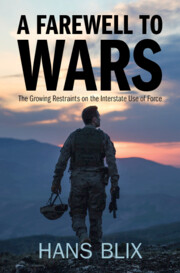Book contents
- A Farewell to Wars
- A Farewell to Wars
- Copyright page
- Contents
- Foreword
- Abbreviations
- 1 Introduction
- 2 Interstate Uses of Force, Tensions and Restraints by Regions since World War II
- 3 Interstate Uses of Force, Tensions and Restraints during Major Phases of International Relations since World War II
- 4 Incentives to the Interstate Uses of Force and Restraints
- 5 Historical Evolution of Norms and Other Means to Restrain the Use of Force
- 6 Overview of Disincentives to and Restraints on the Interstate Use of Force
- 7 Military Strength to Deter Others from Using Force
- 8 Nuclear and Other Non-conventional Weapons and Means as Deterrents and Threats
- 9 Disarmament as Restraint on the Use of Force
- 10 Preventing the Interstate Use of Force by Preventing or Solving Conflicts
- 11 Restraints on the Interstate Use of Force through Legal Norms
- 12 UN Charter Articles Relating to the Use of Force
- 13 The Security Council May Use or Authorize States or Regional Organizations to Use Force
- 14 The Right to Individual and Collective Self-Defence as an Exception to Art. 2:4
- 15 Interventions Triggered by Factors Unforeseen at the Adoption of the Charter’s Ban on the Interstate Use of Force
- 16 Interventions Seeking Regime Change, Protection of People or Punishment
- 17 Findings Regarding the Role of Norms to Restrain the Interstate Use of Force
- 18 States are Saying Farewell to Wars
- Bibliography
- Index
5 - Historical Evolution of Norms and Other Means to Restrain the Use of Force
Published online by Cambridge University Press: 09 November 2023
- A Farewell to Wars
- A Farewell to Wars
- Copyright page
- Contents
- Foreword
- Abbreviations
- 1 Introduction
- 2 Interstate Uses of Force, Tensions and Restraints by Regions since World War II
- 3 Interstate Uses of Force, Tensions and Restraints during Major Phases of International Relations since World War II
- 4 Incentives to the Interstate Uses of Force and Restraints
- 5 Historical Evolution of Norms and Other Means to Restrain the Use of Force
- 6 Overview of Disincentives to and Restraints on the Interstate Use of Force
- 7 Military Strength to Deter Others from Using Force
- 8 Nuclear and Other Non-conventional Weapons and Means as Deterrents and Threats
- 9 Disarmament as Restraint on the Use of Force
- 10 Preventing the Interstate Use of Force by Preventing or Solving Conflicts
- 11 Restraints on the Interstate Use of Force through Legal Norms
- 12 UN Charter Articles Relating to the Use of Force
- 13 The Security Council May Use or Authorize States or Regional Organizations to Use Force
- 14 The Right to Individual and Collective Self-Defence as an Exception to Art. 2:4
- 15 Interventions Triggered by Factors Unforeseen at the Adoption of the Charter’s Ban on the Interstate Use of Force
- 16 Interventions Seeking Regime Change, Protection of People or Punishment
- 17 Findings Regarding the Role of Norms to Restrain the Interstate Use of Force
- 18 States are Saying Farewell to Wars
- Bibliography
- Index
Summary
While the focus of the book is on the interstate use of force post-WWII, this chapter holds a rear mirror and offers a perspective of evolution of restraints that started long before states came into being. It recounts how human societies over the centuries became states free from widespread internal use of armed force and how great powers sought to avoid major armed conflicts through policies of balance of power and multilateral conferences. It describes how they developed common rules by concluding conventions and built institutions such as the League of Nations and the United Nations to create a rule-based order and mechanisms and methods to prevent the interstate use of force.
Keywords
- Type
- Chapter
- Information
- A Farewell to WarsThe Growing Restraints on the Interstate Use of Force, pp. 87 - 106Publisher: Cambridge University PressPrint publication year: 2023

